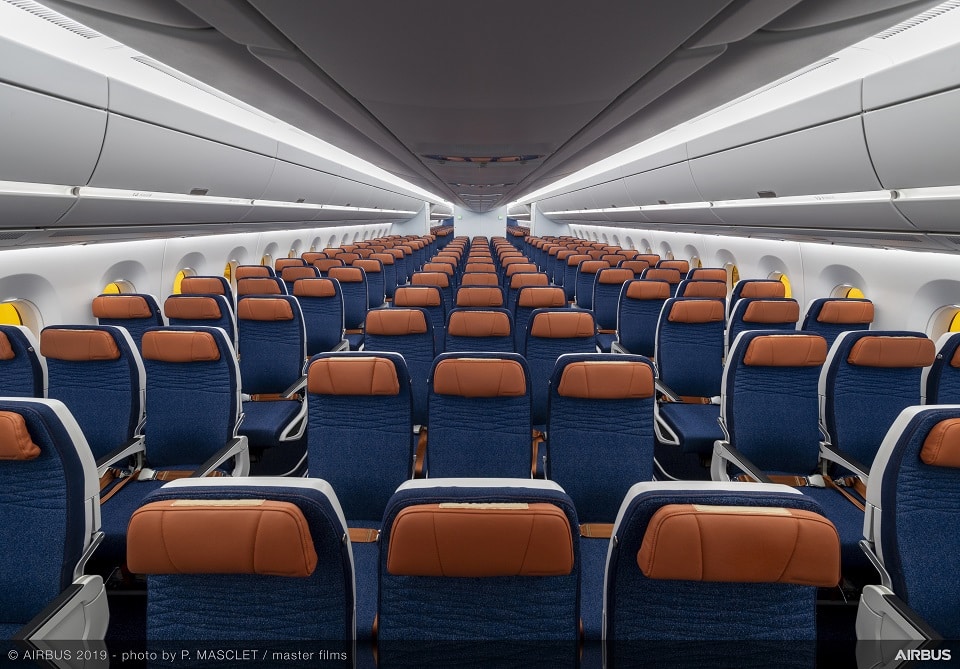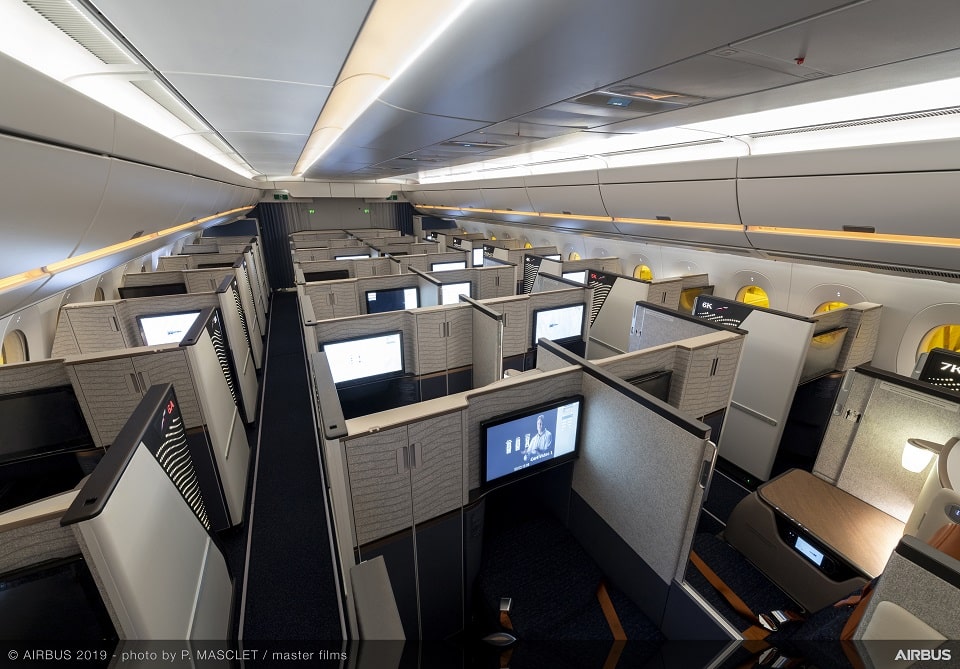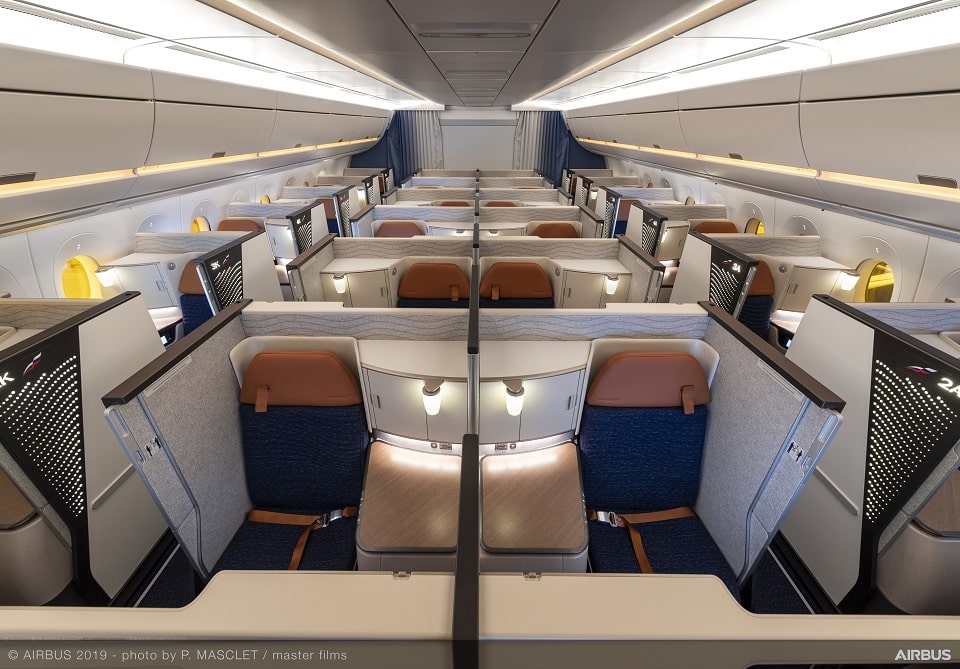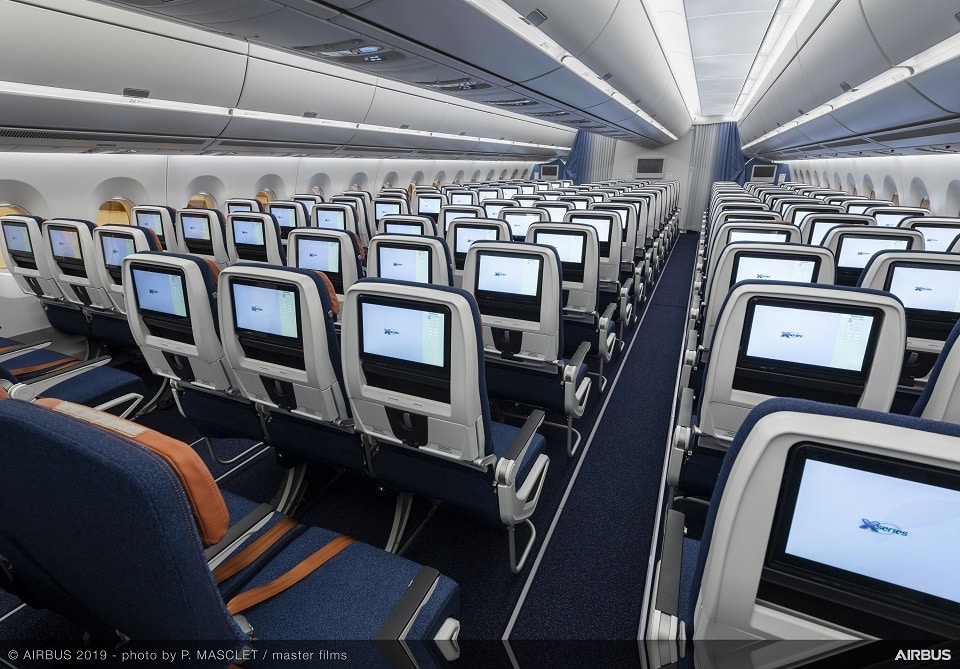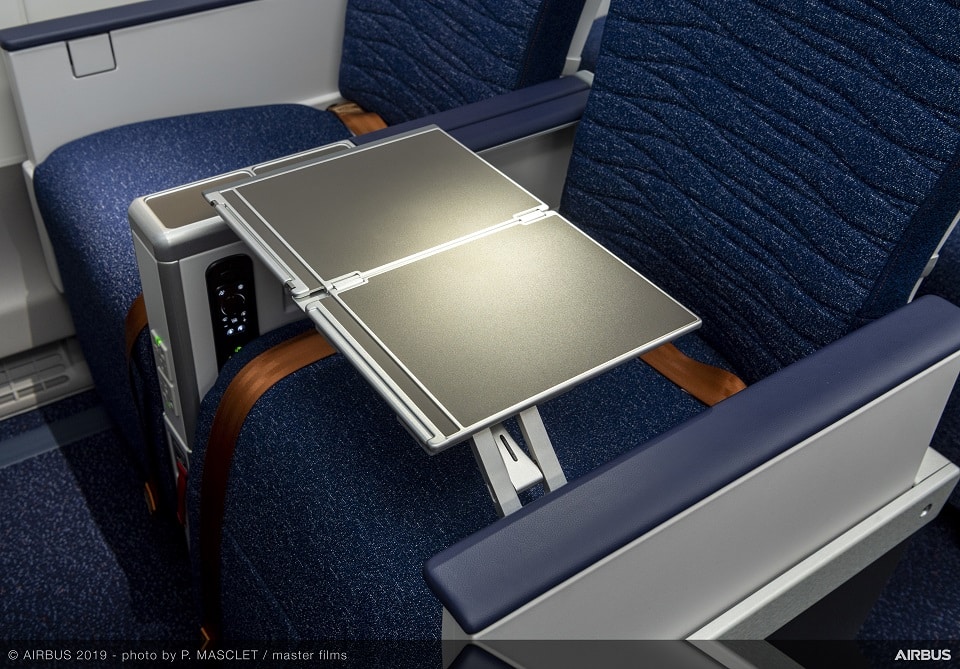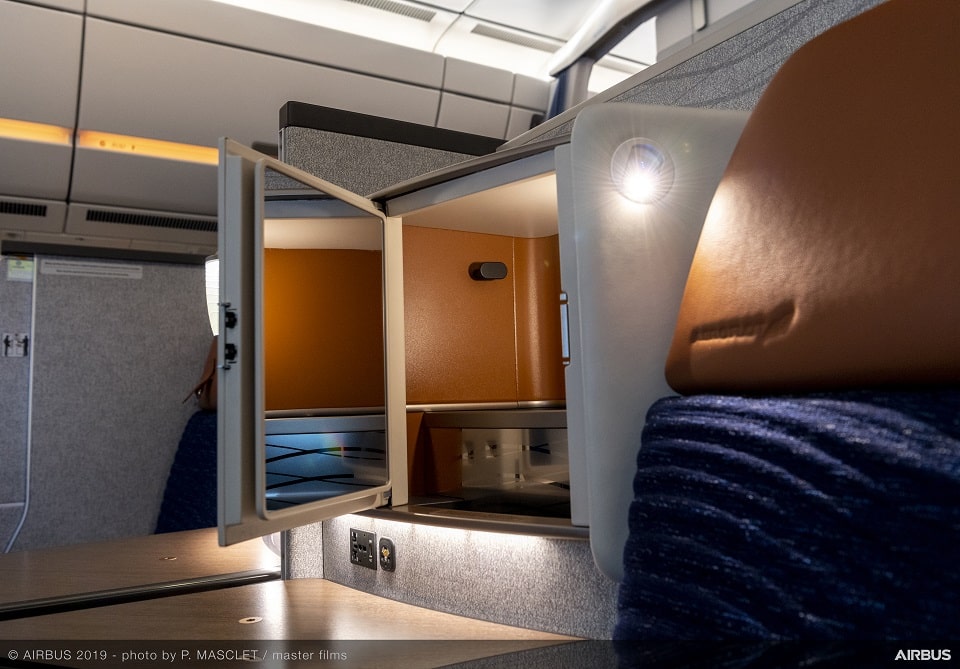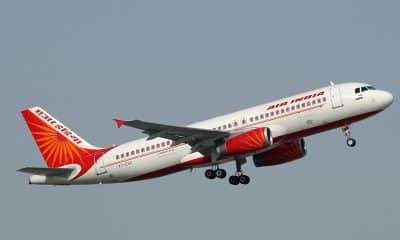Aerospace
This could be Air India’s upcoming A350 cabin, which will definitely draw attention.

Airbus is now in the process of committing to the supply of 34 A350-1000 and six A350-900 aircraft. The six Aeroflot A350 aircraft are in excellent condition and will be delivered to Air India at a price that has been negotiated. The Airbus manufacturing facility is where the planes are.
In Gesture To Israel, Saudi Arabia Opens Airspace To ‘All Carriers’.(Opens in a new browser tab)
Wide and narrow-body aircraft are likely to be introduced into the operations divisions of Air India’s Vihaan 5-year plan for development. The six planes are MSNs 554/558/585/589/592/594. The first #A350 for #AirIndia is scheduled to arrive in 2023, followed by others in close succession.
According to Campbell Wilson, CEO of Air India, the company would continue to use the Aeroflot A350’s current configuration due to supply chain and timing restrictions. The aeroplane’s cabin is decorated in an opulent blue and orange colour scheme. It won’t undergo any alterations, and the external livery for Air India will still be present on the aircraft.
About Aeroflot A350-900
Aeroflot, the Russian flag carrier and member of the SkyTeam alliance. Aeroflot’s A350-900 features a distinctive new livery embracing its almost 100-year heritage. Aeroflot has a total of 22 A350-900 aircraft on order and operates an Airbus fleet of 126 aircraft (107 A320 Family and 19 A330 Family aircraft).
Aeroflot’s A350-900 features a brand-new elegant cabin design, offering unrivalled passenger comfort. The aircraft has a spacious three-class cabin layout with 316 seats: 28 private Business Class suites with full-flat seats, 24 Comfort Class with extra legroom and 264 Economy Class. In addition, the latest-generation Panasonic eX3 in-flight entertainment system, HD screens and Wi-Fi connectivity will ensure an enhanced experience for all passengers on long-haul flights. Aeroflot will operate its A350-900 from Moscow to a number of destinations including London, Dubai, New York, Miami, Osaka and Beijing.
The A350 XWB offers by design unrivalled operational flexibility and efficiency for all market segments – up to ultra-long haul (9,700 nm). Its Airspace by Airbus cabin is the quietest of any twin-aisle aircraft and offers passengers and crews the most modern in-flight flying experience. The aircraft features the latest aerodynamic design, a carbon fibre fuselage and wings, plus new fuel-efficient Rolls-Royce Trent XWB engines.
Together, these latest technologies result in 25% lower operating costs, as well as a 25% reduction in fuel burn and CO2 emissions compared with previous-generation competing aircraft – demonstrating Airbus’ commitment to minimising its environmental footprint while remaining at the cutting edge of air travel.
Air India’s Aircraft orders for Airbus
The Tata Group-owned Air India has announced its commitment to order 250 Airbus aircraft to boost its domestic and international operations. The commitment includes 140 A320neo and 70 A321neo single-aisle aircraft as well as 34 A350-1000 and six A350-900 wide-body jets that will mark a new era for the country as the all-new, long-range aircraft celebrates its debut in the Indian market.
The order aims to both modernise and expand the airline’s fleet with the objective of creating a larger and premium full-service carrier that will cater to the growing travel demand in the region. Deliveries are set to commence with the first A350-900 arriving by late-2023.
The A350 is the world’s most modern and efficient wide-body aircraft in the 300-410 seater category. The A350’s clean sheet design includes state-of-the-art technologies and aerodynamics delivering unmatched standards of efficiency and comfort.

Aerospace
Indigo will soon launch Air Taxi Service in India

InterGlobe Enterprises, the parent brand of IndiGo, is set to revolutionize travel in India with its upcoming air taxi service.
Scheduled for a potential launch in 2026, this innovative venture promises a seamless journey for passengers between two bustling hubs. Delhi and Gurgaon in Haryana. The forthcoming service is projected to revolutionize the daily commute, offering passengers a swift aerial journey covering the distance in a mere 7 minutes.
This remarkable efficiency contrasts starkly with the conventional 90-minute drive, underscoring the immense time-saving potential for commuters. The anticipated fare, ranging from Rs 2,000-3,000, makes this innovative mode of transport not only swift but also remarkably competitive in pricing.
At the heart of this ambitious endeavor lies a strategic partnership with Archer Aviation, a pioneer in electric vertical takeoff and landing (eVTOL) aircraft technology. Under this collaboration, Archer will supply 200 state-of-the-art eVTOL aircraft, representing an investment of US$ 1 billion. These cutting-edge aircraft, capable of accommodating up to four passengers alongside the pilot, epitomize the future of sustainable air travel.
Powered by six battery packs, Archer’s eVTOL aircraft boast rapid charging capabilities, enabling a swift turnaround between flights. With a charging time of just 30-40 minutes, these eco-friendly aircraft ensure minimal downtime, maximizing operational efficiency.
Similar services are anticipated to be introduced by the joint venture in Bengaluru and Mumbai as well. Nevertheless, the service rollout period has not yet been made public by the company. Next year, it is anticipated to get its certification. Following this, the company will start the certification procedure with the Directorate General of Civil Aviation (DGCA).
Aerospace
Which is bigger 777x or 787 aircraft ?

The 777X is a new series of the Boeing 777 family and is designed to be larger and more efficient than its predecessor. It features two variants: the 777-8 and the 777-9, being the larger of the two.
The Boeing 777X emerges as the larger sibling within the Boeing family, representing a significant leap forward in both size and efficiency. Comprising two variants, the 777-8 and the 777-9, the latter takes the crown as the larger of the two. With its expansive fuselage and impressive wingspan, the 777X is tailored for long-range journeys and boasts a substantial passenger capacity.
On the other hand, the Boeing 787, affectionately known as the Dreamliner, occupies a niche in the market as a smaller yet formidable aircraft designed for medium to long-range flights. Its distinguishing feature lies in its composite fuselage, a technological marvel that renders it lighter and more fuel-efficient compared to conventional aluminum counterparts. The Boeing 777X is larger than the Boeing 787 aircraft.
When it comes to passenger capacity, the 777-9 reigns supreme, typically accommodating a sizeable contingent of 400-425 passengers in its standard configuration. In contrast, the 787, with its more modest dimensions, typically carries between 240-290 passengers, depending on the variant and layout.
One of the remarkable innovations introduced with the 777X is its folding wingtips, a feature designed to address the logistical challenges of accommodating such a large aircraft in conventional airport gates. These folding wingtips enable the 777X to retract its wings, allowing it to fit into gates designed for smaller aircraft while still reaping the benefits of an extended wingspan during flight, thereby enhancing fuel efficiency and operational flexibility
Aerospace
China Secures Production Certificate for Mass Production of Pilotless eVTOL Aircraft

The first passenger-carrying pilotless electric vertical takeoff and landing (eVTOL) aircraft in the world, the EH216-S, has received the Production Certificate for its eVTOL aircraft from the Civil Aviation Administration of China (CAAC).
This is a significant milestone for EHang Holdings Limited, the leading UAM technology platform company in the world. This outstanding accomplishment is another big step towards mass manufacturing for the eVTOL aircraft and the ensuing commercial operations, building on the ground-breaking acquisition of the Type Certificate and the Standard Airworthiness Certificate for the EH216-S.
The PC is a crucial certificate that the aircraft maker receives from the CAAC, the country’s aviation authority. By obtaining this certificate, EHang has demonstrated that it has set up a quality management system for mass production that satisfies the airworthiness regulation standards set forth by the CAAC, and the company has been given permission to continue producing mass quantities.
It is also a strong guarantee of the calibre of the goods made by EHang. Raw materials, supplier management, manufacturing organisation, production quality control, aircraft pre-delivery test, after-sales repair and maintenance, etc. are all included in the mass production quality management system for the EH216-S.
To ensure that every aircraft and its components that roll off the production line strictly adhere to the approved type design and safety requirements, the system sets clear guidelines and documentation for every step in the production procedure. This ensures comprehensive traceability and safety control.

